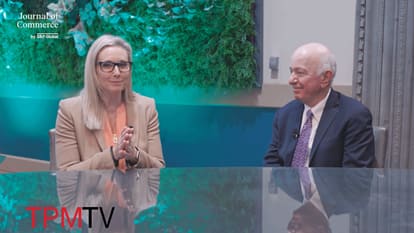- Program
- What's New
- Speakers
- Who's Attending
- TPM Community
- Partners
- Media

TPM TV
Episodes of exclusive TPM content featuring interviews of key stakeholders and attendees.
WATCH NOW - About

About TPM
The must-attend conference for the trans-Pacific and global container shipping and logistics community
LEARN ABOUT TPM - Get Updates
- FAQ's
Sessions With Ari Ashe
Monday, 4 March
-
02:00pm - 02:30pm (PST) / 04/mar/2024 10:00 pm - 04/mar/2024 10:30 pm
A Conversation With Union Pacific President Beth Whited
When the inevitable rebound in international intermodal volume occurs, the Class 1 North American railroads’ performance will be under a microscope. Intermodal service was consistent and reliable in 2022, but was it only because volume was weak? Or have railroads learned their lessons from 2020-2022 and will handle volume surges better going forward? Many are worried that nothing has changed and, when West Coast port volume surges again, so will the crippling congestion at on-dock rail facilities and inland terminals in Chicago, Dallas, Memphis, and Kansas City. Union Pacific has made several investments to address how cargo owners are diversifying their supply chains. It has begun new service with Ferromex in Mexico, connecting shippers to the Midwest and Southeast US. It has begun new service between Port Houston and several Midwest destinations. It also has opened a new international intermodal terminal in Phoenix to capture some short-haul traffic from the Port of Los Angeles and Port of Long Beach. The new services not only aim to take traffic off the highways but also to serve customers who are concerned about their carbon footprints. In this much-anticipated session, Journal of Commerce senior editor Ari Ashe will sit down with Union Pacific president Beth Whited to discuss these issues and how UP will keep the freight flowing in 2024.- Speakers:
- Beth Whited
- Ari Ashe
-
04:10pm - 04:55pm (PST) / 05/mar/2024 12:10 am - 05/mar/2024 12:55 am
Are the Railroads Ready for the Next Intermodal Surge?
Now that the cargo volume surge of 2020 to 2022 has passed, the international supply chain has time to pause and examine what went well, what didn’t, and how to adjust for the next upswing. When examining ocean containers moving to inland rail ramps, there could be many changes forthcoming. Norfolk Southern Railway has begun a multi-year effort to convert wheeled terminals into a port-like grounded model and to introduce appointment systems to reduce truck turn times. Union Pacific Railroad is grounding all imports from California into the Global 4 terminal in Joliet and eliminated the no cherry-picking policy. This session will examine how railroads will learn from history as they prepare for the inevitable turnaround and next wave of cargo.- Speakers:
- Dan Bresolin
- Shawn Tureman
- Thomas Williams
- Ari Ashe
-
05:00pm - 05:45pm (PST) / 05/mar/2024 01:00 am - 05/mar/2024 01:45 am
East Coast Ports: The Battle Between Truck and Rail
While the market share of Asian imports has shifted back toward the West Coast, most savvy cargo owners have a diversified port strategy with volume going to all coasts. Like diversifying portfolios, using a diverse number of ports reduces risk. Nevertheless, there are key differences between US West Coast and US East Coast ports. Perhaps the most important is how much inland movement happens on trucks versus trains. On the West Coast, few inland moves to the US heartland are done via trucks because the distance to key hubs such as Chicago, Dallas, Memphis, and Kansas City is 1,500 to 2,500 miles. On the East Coast, however, drayage handles the majority of moves to key hubs in Atlanta, Charlotte, and Harrisburg/Allentown. Transloading, while also popular, highlights a key difference. On the East Coast, loads are almost always transloaded into dry-van trailers and hauled on the highway to destinations in Illinois, Indiana, Iowa, Kentucky, Michigan, and Ohio. On the West Coast, loads are usually transloaded from an ocean container to a domestic container. This session will explore how ocean carriers, railroads, port officials, and cargo owners can come together to increase the usage of international intermodal, taking share off the highways between the port and final destinations. It will examine the role ocean carriers and railroads play in offering such services to cargo owners and what long-term commitments are necessary to change old patterns.
Tuesday, 5 March
-
10:30am - 11:00am (PST) / 05/mar/2024 06:30 pm - 05/mar/2024 07:00 pm
TPM24 CEO Series: A Conversation with TRAC Intermodal's Daniel Walsh
After two tumultuous years for chassis providers, things were unusually quiet in 2023. But most cargo owners would say they’re skeptical that a rebound in port volumes in 2024 won’t yield a repeat of the same problems in the supply chain. Chassis providers believe things will be better the next time around, but will they? In this highly anticipated session, Journal of Commerce senior editor Ari Ashe will sit down with TRAC CEO Dan Walsh to discuss cargo owners’ skepticism, what chassis providers have done to apply lessons learned, what reasonable expectations importers and exporters should place on TRAC going forward, and how to measure whether those expectations are being met.
- Speakers:
- Daniel Walsh
- Ari Ashe

